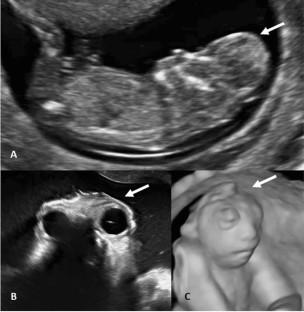Archives of Gynecology and Obstetrics ( IF 2.1 ) Pub Date : 2022-05-12 , DOI: 10.1007/s00404-022-06584-3 Julia Bijok 1, 2 , Sylwia Dąbkowska 1 , Anna Kucińska-Chahwan 3 , Diana Massalska 1, 2 , Beata Nowakowska 3 , Sylwia Gawlik-Zawiślak 4 , Grzegorz Panek 1, 2 , Tomasz Roszkowski 1, 2

|
Objectives
To analyse additional structural and genetic anomalies in fetuses with acrania/exencephaly/anencephaly sequence (AEAS).
Methods
A retrospective analysis of 139 fetuses with AEAS diagnosed between 2006 and 2020 in a single tertiary referral ultrasound department.
Results
The median gestational age at diagnosis decreased from 15 weeks in 2006 to 13 weeks in 2020 (− 0.21 per each year; p = 0.009). In 103 fetuses, the defects were limited to the neural tube (NTD) (74.1%), in 36 fetuses (25.9%), there were additional structural non-NTD anomalies. The most common were ventral body wall defects present in 17.8% (23/139), followed by anomalies of the limbs (7.2%; 10/139), face (6.5%; 9/139) and heart (6.5%; 9/139). Genetic anomalies were diagnosed in 7 of the 74 conclusive results (9.5%; 7/74; trisomy 18, n = 5; triploidy, n = 1; duplication of Xq, n = 1). In univariate logistic regression models, male sex, limb anomalies and ventral body wall defects significantly increased the risk of genetic anomalies (OR 12.3; p = 0.024; OR 16.5; p = 0.002 and OR 10.4; p = 0.009, respectively).
Conclusions
A significant number of fetuses with AEAS have additional structural non-NTD anomalies, which are mostly consistent with limb body wall complex. Genetic abnormalities are diagnosed in almost 10% of affected fetuses and trisomy 18 is the most common aberration. Factors that significantly increased the odds of genetic anomalies in fetuses with AEAS comprise male sex, limb anomalies and ventral body wall defects.
中文翻译:

颅脑畸形/无脑畸形/无脑畸形序列 (AEAS) 的产前诊断:额外的结构和遗传异常
目标
分析头颅/无脑畸形/无脑畸形序列 (AEAS) 胎儿的其他结构和遗传异常。
方法
对 2006 年至 2020 年在单一三级转诊超声科诊断为 AEAS 的 139 例胎儿进行回顾性分析。
结果
诊断时的中位孕龄从 2006 年的 15 周减少到 2020 年的 13 周(每年 − 0.21;p = 0.009)。在 103 个胎儿中,缺陷仅限于神经管 (NTD) (74.1%),在 36 个胎儿 (25.9%) 中,存在额外的结构性非 NTD 异常。最常见的是腹侧体壁缺陷,占 17.8% (23/139),其次是四肢异常 (7.2%; 10/139)、面部 (6.5%; 9/139) 和心脏 (6.5%; 9/ 139). 74 个结论性结果中有 7 个被诊断出遗传异常(9.5%;7/74;18 三体,n = 5;三倍体,n = 1;Xq 重复,n = 1)。在单变量逻辑回归模型中,男性、肢体异常和腹侧体壁缺陷显着增加了遗传异常的风险(OR 12.3;p = 0.024;或 16.5;p = 0.002 和 OR 10.4;p = 0.009,分别)。
结论
相当多的 AEAS 胎儿有额外的结构性非 NTD 异常,这些异常大多与肢体壁复合体一致。几乎 10% 的受影响胎儿被诊断出遗传异常,18 三体是最常见的畸变。显着增加 AEAS 胎儿遗传异常几率的因素包括男性、肢体异常和腹侧体壁缺陷。































 京公网安备 11010802027423号
京公网安备 11010802027423号